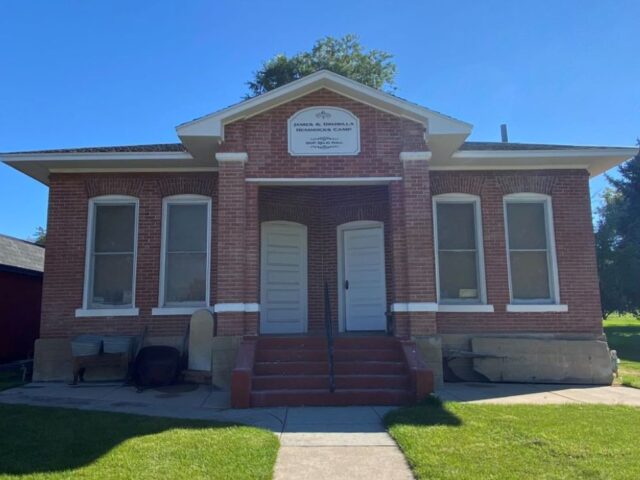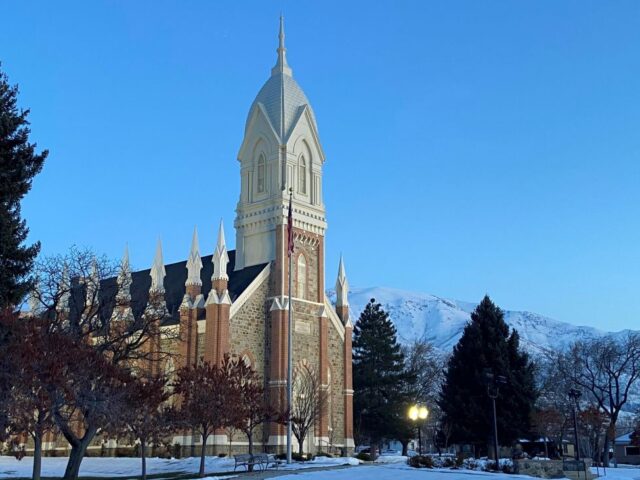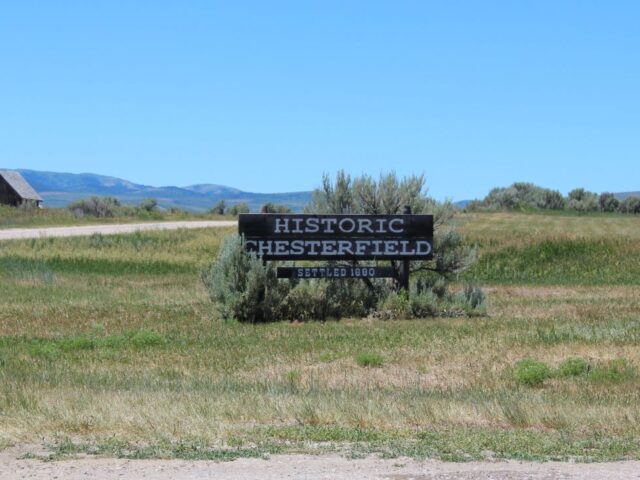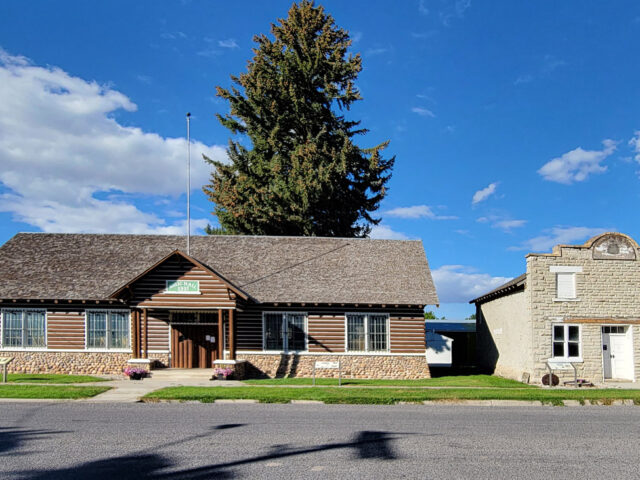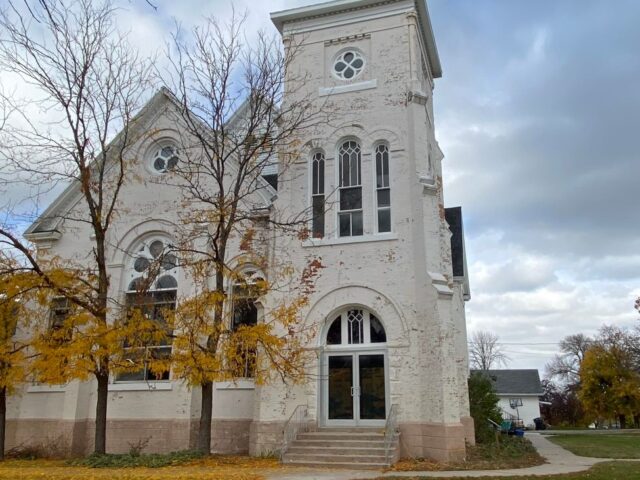Category: Mormon Sites
Heritage Area Mormon Sites including historic homes, stores, farms and churches in Northern Utah and Southeast Idaho.
Choose An Experience!
The James and Drusilla Hendrick's Camp Relic Hall is run by the Daughters of Utah Pioneers. Early Mormon, Native American, and other local history artifacts are preserved in this museum. Originally built for a Latter-day Saint Stake President as an office, the building is now owned by the city. The…
View moreBuilt on “Sagebrush Hill,” on a site chosen in 1865 by Brigham Young himself, this tabernacle took nearly fifteen years to build, then it was gutted by fire in 1896. The formerly somewhat plain building was rebuilt with a Gothic Revival tower and sixteen pinnacles. Free guided tours are available…
View moreHoused in Perry’s century-old former Mormon church building, the Heritage Community Theatre offers musicals, children’s theatre, and drama.
View moreThe Richmond Relief Society Hall is a historic Latter-day Saint building in Richmond, Utah. It was built during 1880 and is listed on the National Register of Historic Places. It is one of the oldest known Relief Society Halls still remaining in Utah. Currently, the building is closed for remodeling.
View moreThe Tabernacle was completed in 1891 and is a striking example of an early Mormon pioneer public meetinghouse. A beautiful pipe organ was installed in 1908 and the building is used for Church conferences, community concerts, and other presentations. An extensive genealogy library is located in the basement of the…
View moreIn 1881-1882, Mormon settlers came to this area north of Bancroft at the invitation of their friend and relative Chester Call, who had established a ranch nearby. Their hope was to build a thriving community, but in 1882, the Oregon Short Line Railroad was built through Bancroft instead of their…
View moreThe village of Franklin is the oldest European-American settlement in Idaho, having been established in April, 1860 by Mormon pioneers moving northward from Utah. The Relic Hall, a museum of local history, is housed in a log building that was built as a museum in 1937 as homage to the…
View moreStarted in 1861 and finished in 1927, the Logan Fourth Ward building has been renovated throughout the years, but much of the original architecture remains with beautiful woodwork, a mural, and stained glass. It used to house the Logan Family History Center, but the center is now located in a…
View moreThe Church of Jesus Christ of Latter-day Saints Temple is an easily visible icon of the Cache Valley landscape. The edifice was designed by Mormon architect Truman O. Angell, and built from 1877-1884 by the donated labor of early pioneers. The modified Gothic building rests on a terrace of the ancient Lake Bonneville, and…
View moreOn this route, travelers can retrace some steps of Idaho's pioneers and follow the path taken by early-day Yellowstone Park visitors. From Franklin, Idaho's oldest settlement, it follows US Hwy 91 north to Preston, then Idaho State Hwy 34 north through Thatcher and Grace to US Hwy 30. It then goes east…
View moreView mountain man and early pioneer relics and enjoy reading historical accounts of Cache Valley natives. Open June to September (Labor Day) or other times of the year by appointment
View moreThis block housed the first department store in Idaho, the Evans Co-op, which was part of the Mormon cooperative movement of the 1860s, in which local production and purchasing was encouraged through cooperatives. The block, including both the co-op building and the old J.N. Ireland Bank, is on the National…
View moreFind out about your family history at this fascinating center, which has computers that tie into the famous genealogy library located in Salt Lake City. Just type in your name, and find a long-lost relative! You can also reserve a time to digitize materials such as VHS and cassette tapes….
View moreThis two room log cabin houses artifacts and information about early Mormon leaders. Wilford Woodruff, the third president of the Church of Jesus Christ of Latter-day Saints lived here. The building now serves as a visitors information centers. Tours of the cabin are available.
View moreDress as pioneers decked in a bonnet or hat of the times and pull handcarts to 20 campsites where you learn interesting pioneer history and reenact actual pioneer experiences. For example: getting caught in a cloudburst, scrubbing clothing on a wash board, negotiate with Native Americans for buffalo jerky, shaking…
View moreThe Hatch house is a Greek Revival style house built with local limestone in 1872 by Lorenzo H. Hatch, one of the earliest settlers of Franklin. A carpenter and farmer, he was the first Mormon Idaho legislator and served as mayor and Mormon bishop of Franklin. Since Hatch was the local bishop, he built…
View moreThe first designated historic district in Utah, the Willard district reflects the Welsh heritage of many of the earliest settlers. The main builder of the homes was Shadrach Jones, a Welsh stonemason, and the homes are mainly Greek Revival and Gothic in style, forming the largest grouping of pioneer stone…
View moreBuilt from 1903 to 1905, the historic Old Hyrum First Ward Meetinghouse is a striking example of late Gothic Revival Style, and remains a prominent feature of the Hyrum landscape. Listed on the National Register of Historic Places, this building represents the local community in its materials and work ethic.
View moreA summer cabin was built in 1870 for Latter-day Saint (Mormon) Church President Brigham Young. The cabin was used for many years as a stopping place for Young and other church leaders as they traveled through the area doing church business. The home was destroyed in 1944 in an attempt…
View moreThis tabernacle was once used as a meeting house by early members of the Church of Jesus Christ of Latter-day Saints (Mormons). It was built in 1908 and reflects Mormon architecture at the beginning of the twentieth century. Its Gothic English architecture and chapel with balcony, wooden benches and slanting…
View moreThe Oneida Stake Academy was one of many schools founded by the Church of Jesus Christ of Latter-day Saints. It was started in 1888 in Franklin, Idaho. When the time came in 1889 to build a building for the academy, Preston was chosen as the location because it was centrally…
View moreIn the 1860s, Brigham Young instituted what came to be known as the “cooperative movement” in Utah. With the new transcontinental railroad came goods made elsewhere, and the church leaders feared that materialism and covetousness would grow among the Mormons. A system of businesses owned cooperatively was created, with existing…
View moreWhitney was the boyhood home of Ezra Taft Benson who served as Secretary of Agriculture in the Eisenhower Administration, and as President of the Church of Jesus Christ of Latter-Day Saints from 1985 to 1994. The home in which he was raised and the red gambrel roofed barn sill stand on…
View more
